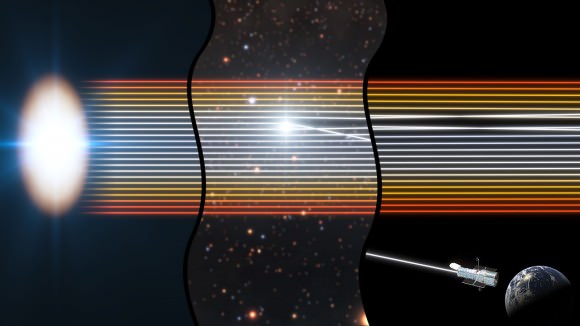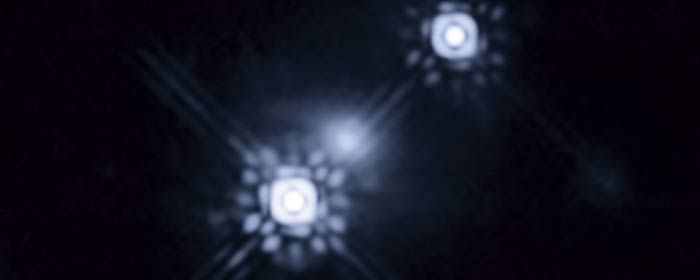[/caption]
Thanks to the magic of the NASA/ESA Hubble Space Telescope, a team of international astronomers have made an incredible observation – a quasar accretion disc surrounding a black hole. By employing a technique known as gravitation lensing, the researchers have been able to get an accurate size measurement and spectral data. While you might not think this exciting at first, know that this type of observation is akin to spotting individual grains of sand on the Moon!
Of course, we know we can’t see a black hole – but we’ve learned a lot about them with time. One of their properties is a bright, visible phenomenon called a quasar. These glowing discs of matter are engaged in orbit around the black hole, much like a coil on an electric stove. As energy is applied, the “coil” heats up and unleashes bright radiation.
“A quasar accretion disc has a typical size of a few light-days, or around 100 billion kilometres across, but they lie billions of light-years away. This means their apparent size when viewed from Earth is so small that we will probably never have a telescope powerful enough to see their structure directly,” explains Jose Munoz, the lead scientist in this study.
Because of the diminutive size of the quasar, most of our understanding of how they work has been based on theory… but great minds have found a way to directly observe their effects. By employing the gravity of stars in an intervening galaxy like a scanning microscope, astronomers have been able to observe the quasar’s light as the stars move. While most of these types of features would be too small to see, the gravitation lensing effect ramps up the strength of the quasar’s light and allows study of the spectra as it cruises across the accretion disc.

By observing a group of gravitationally lensed quasars, the team was able to paint a vivid color portrait of the activity. They were able to pick out small changes between single images and spectral shifts over a period of time. What causes these kaleidoscopic variances? For the most part, it’s the different properties in the gases and dust of the lensing galaxies. Because they travel at different angles to the quasar’s light, scientists were even able to distinguish extinction laws at work.
But there was something special about one of the quasars. Says the Hubble Team, “There were clear signs that stars in the intervening galaxy were passing through the path of the light from the quasar. Just as the gravitational effect due to the whole intervening galaxy can bend and amplify the quasar’s light, so can that of the stars within the intervening galaxy subtly bend and amplify the light from different parts of the accretion disc as they pass through the path of the quasar’s light.”
By documenting these color changes, the team could build a profile of the accretion disc. Unlike our Earthly electric stove coil which glows red as it heats up, the accretion disc of a black hole turns blue as it gets closer to the event horizon. By measuring the blue hue, the team was able to measure the disc diameter and the various tints gave them an indicator of distances from its center. In this case, they found that the disc is between four and eleven light-days across (approximately 100 to 300 billion kilometres). Of course, these are only rough estimates, but considering just how far away we’re looking at such a small object gives these types of observations great potential for future studies… and even improvements on accuracy.
“This result is very relevant because it implies we are now able to obtain observational data on the structure of these systems, rather than relying on theory alone,” says Munoz. “Quasars’ physical properties are not yet well understood. This new ability to obtain observational measurements is therefore opening a new window to help understand the nature of these objects.”
Original Story Source: ESA/Hubble News Release. For Further Reading: A Study of Gravitational Lens Chromaticity With the Hubble Space Telescope.


That image is amazing….. and am wondering after it. The symmetrical bright spots are caused by? deconvolution artifacts in the original image? Instrument grating? Or distant galaxies mirrored around the gravity well? Or…?
I think the symmetrical spots are due to diffraction with the instrumentation. This appears to be some artifact of the optics.
LC
Agreed… and yet, in some of the gravitational lensing images I’ve seen, there are symmetrical yet unevenly magnified images of one object, usually a distant galaxy, which appear on opposing sides of the gravitational lens itself. WERE the features in the above image caused by that instead of diffraction, it would indicate a VERY evenly ‘focused’ lensing event or lens element… indicating some entirely new type of lens?
In this case it is however the supportrods holding the secondary mirror in place that gives the very distinguishable diffraction pattern you see for the bright spots.
More….? http://www.stsci.edu/institute/org/telescopes/Reports/krist_tinytim_spie.pdf
That image is amazing….. and am wondering after it. The symmetrical bright spots are caused by? deconvolution artifacts in the original image? Instrument grating? Or distant galaxies mirrored around the gravity well? Or…?
That image is amazing….. and am wondering after it. The symmetrical bright spots are caused by? deconvolution artifacts in the original image? Instrument grating? Or distant galaxies mirrored around the gravity well? Or…?
If someone could please explain the image.
At first I thought that those 2 main bright things might be quasars accretion discs (I even recall hearing somewhere that stuff swirling around BH might be layered, similar to electron cloud orbitals in atom, as it also has some favorable ‘energy levels’).
But then I realized that those must be just other galaxy stars that they used as a gravitational lens (btw using star from other galaxy as a lens – wow!) and the actual quasar is to the top right of the central ‘star’ on the picture? But how on earth (or space) we can see stars from other galaxies in such detail?! Are we using a ‘double lens’ here – stars from lensed galaxy are lensing even more distant quasar… don’t think so.
Or third option – those 2 bright objects are stars from quasar hosting galaxy but then how a star can appear brighter then quasar… so don’t think that’s explanation either.
Sorry for being silly but I’m a ‘lil bit confused here (probably missed something in the article). Anyway, would be glad to hear an explanation.
Those 2 are stars from the lens galaxy. The quasar is in between and far behind, Z of the lens galaxy is around 0.7 and the quasar around 2.2.
“But how on earth (or space) we can see stars from other galaxies in such detail?!”
That’s a good question. I don’t know. One would think that those are foreground stars in our galaxy. I guess Hubble is Hubble and when you specifically look for something, you can do it, it’s not like taking a picture of a galaxy, but I could be wrong…
Here is the video.
http://www.spacetelescope.org/videos/heic1116a/
“Are we using a ‘double lens’ here – stars from lensed galaxy are lensing even more distant quasar… don’t think so.”
No, however, they say under the video that they combined micro and macro lensing to do the job.